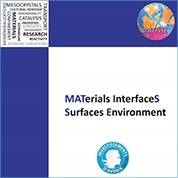THEORY AND MODELS
Objectives
Computer modeling of materials has a central role for the Labex. Indeed, the capability of calculating with high accuracy material properties opens the way to use computer modeling to design new materials, to predict material behavior under particular environmental conditions - before or in absence of experimental investigations-, as well as to get a physical insights and disentangle distinct effects in the experimental data. In order to meet those objectives, the simulation approaches should be accurate and cover different length and time scales. Multi-scale approaches have been implemented and employed on several problems, often in a collaborative context. Another goal is the direct modeling of the advanced experimental probes that are used by other partners within the Labex.
The previous requirements constitute a challenge for theory and models, as new and original methods should be developed. This fact has been an important motivation to define the main role of this axes in the design and implementation of new and original methods, beyond existing codes and models that are routinely used. These new methods are not restricted to a particular subject but could cover several domains in the Labex, thus giving the theoretical axes a peculiar transverse character that (1) reinforces its theoretical flavor and (2) opens up new perspectives for collaborations with experimental partners in other axes.
Partner Teams
PASTEUR, IMPMC, INSP, IFP-EN, PHENIX, LPTMC, ISTEP, LCMCP
Highlights
An example of the implementation of new methods that are closer to the experimental conditions, can be found in the PhD thesis work by R. Nemausat, supervised by D. Cabaret (IMPMC) and C. Gervais (LCMCP). The focus is on the inclusion of the effects due to atomic motion on X-ray absorption (XANES) and Nuclear Magnetic Resonance (NMR) spectra. They are experimentally probed and theoretically modeled by using an original ab initio approach, which includes both harmonic and anharmonic contributions. Successfully tested on MgO, more complex crystals, like AlPO4, Al2O3 and SiAl2O5 are under study.
Going beyond the limited time and length scales that are inherent to a specific method is the challenge that has been undertaken by V. Haigis in a post-doc project inspired by R. Vuilleumier (PASTEUR). In order to understand the solubility and transport of silver and gold in hydrothermal conditions, a key problem in geology, they are coupling simulations at the atomic scale, which can provide an accurate thermodynamic database, with suitable models for geological time scales. At the atomic scale, Au forms stable complex with the S-3 radical, which raises new questions about the formation of gold deposits in the earth crust. A paper has been submitted to Nature Geoscience.
The funded projects cover a wide spectrum of subjects in the Labex: the Ph.D. thesis started in 2012 along a joint LPTMC, IMPMC, PECSA project on the phase diagram and mechanical properties of borates; the Ph.D. thesis by N. Mas started in 2014, supervised by C. Brouder – IMPMC and F. Baudelet, SOLEIL, on the ab initio theory of x-ray magnetic dichroism of materials under pressure; a new grant has been given to researchers at IMPMC and PHENIX for a post-doc working on the implementation of accelerated molecular dynamics schemes to explore and distinguish among amorphous with specific physico-chemical properties, relying on topological concepts.
Benefits of MATISSE
All the funded projects imply collaborations between distinct research groups. The mere presence of one axis devoted to theory and modeling stimulated many discussions between theoreticians at UPMC that otherwise would not have been possible. If some contacts resulted in well-defined collaborative projects, some could not be funded by MATISSE despite their good scientific quality, but many other discussions and informal seminars have been conducted and might lead to new collaborations in a next future.
Additionally, discussions between MATISSE physicists and chemists gave rise to the organization of a summer school co-funded by SU and MATISSE, the "Paris International School on Advanced Computational Materials Science", intended to become a school of reference in the field. The first one will occur in August 2015.
Also in the section
Key figures
MATISSE :
4 disciplines
- Chemistry
- Physics
- Earth Science
- Cultural heritage
18 partners
400 researchers
Contact
Direction :
Florence Babonneau
Administration :
Laurence Bonnet-Lericque
Communication :
Tél. (33) 1 44 27 62 36




